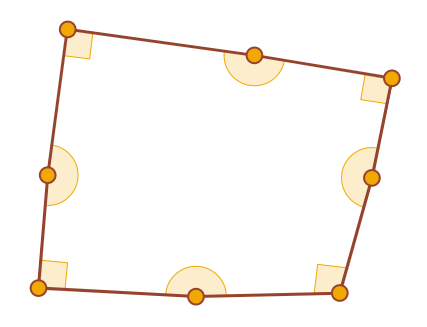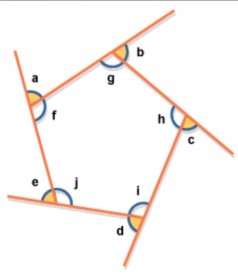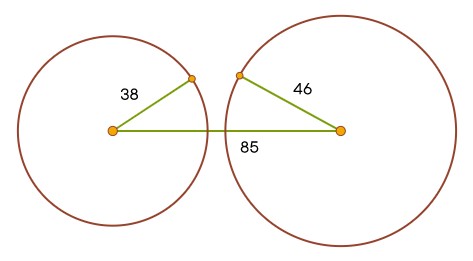
Construct a convex octagon with four right angles.
Probably the fact that I give such assignments says a lot about me as a teacher. I watch students try to line up right angles consistently. When they fail, they try to intersperse right angles. Failing again, they randomly insert them into the polygon. The rattle of their brains during thought effort is music to the teacher's ears.
Then they get suspicious and start asking questions. “You mentioned right angles. Maybe you really meant three corners? ”,“ You definitely meant a convex polygon? ”,“ Four right angles, in fact, form a rectangle. How can we get four more sides in the octagon? " I listen carefully, nod, confirming their guesses.
Finally, someone asks a question that no one dared to ask, the question that I was waiting for: "Hey, is this even possible?"
This question has the power to change the way you think in mathematics. Those who thought narrowly about specific conditions must now think more broadly about how these conditions fit together. Those working within the system must take a step back and study the system itself. Throughout the history of mathematics, this question has been asked many times, puzzled by those who solved the problem of squaring the circle to get around the city of Königsberg . And this question allows us to formulate what mathematics is and how we understand it.
For example, finding an octagon with certain properties is very different from the task of demonstrating that such an octagon cannot exist. Experimenting with different octagons, we might come across one with four right angles.

This is not an example. In fact, this octagon does not have four right angles.
But luck plays no role in proving that such an octagon cannot exist. It requires deep knowledge, not only of polygons, but of mathematics itself. To account for the impossibility, we need to understand that simply assuming the existence of an object does not prove its existence. Mathematical definitions, properties, and theorems live under pressure from their interconnectedness. In trying to represent an octagon with four right angles, we are within these interrelated rules.
But to realize that an octagon is impossible, we need to step back and look at the big picture. What mathematical and geometric principles can be violated by an octagon with four right angles? A good place to start here is with the sum of the angles of a polygon.
The sum of the interior angles of an n- sided polygon is determined by the formula:
S = ( n - 2) × 180º
This happened because each n- sided polygon can be cut into ( n - 2) triangles, the sum of the interior angles of each of which is 180º.
In the case of an octagon, this means that the sum of its interior angles is (8 - 2) × 180º = 6 × 180º = 1080º. Then if four of its corners are straight, that is, each is 90º, then this is 4 × 90º = 360º of the total angles. This means that 1080º - 360º = 720º remains for the remaining four corners of the octagon.
This means that the average for the four remaining corners should be:
But the interior angles of a convex polygon must be less than 180º, which is impossible. A convex octagon with four right angles cannot exist.
Proving the impossibility in this way requires taking a step back and seeing how various mathematical rules, for example, the formula for the sum of the angles of a polygon and the definition of a convex polygon, exist in mutual pressure. And since impossibility proofs rely on broader reasoning over a set of rules, there are often several ways to construct such a proof.
Let's go back to our previous observation that four right angles make up a rectangle.

Outside corners of the polygon.
If the octagon had four right angles, then going around only these corners, we would have made a full circle, as if we had completely walked around the rectangle. This thought leads us to a rule that provides yet another proof of impossibility. It is known that the sum of the outer angles of a convex polygon is always 360º. Since the outer corner of a right angle is also a right angle, our four right angles make up the entire 360º of the sum of the outer angles of the octagon. That is, the rest of the four corners have nothing left, and we again established that such an octagon is impossible.
Proving something is impossible is a powerful mathematical event. It shifts our point of view, we go from obeying rules to controlling rules. And to control the rules, we need to understand them first. We must not only know how to apply them, but also situations in which they are not applicable. And also find situations in which the rules may conflict with each other. In the process of studying the octagon, we identified the relationship of polygons, convexity, right angles and sums of angles. And this emphasizes that S = ( n - 2) × 180º is not just a formula: it is one of the conditions in the world of conflicting conditions.
Proofs of impossibility can help us better understand all areas of mathematics. In school, probability theory lessons often begin with tossing many imaginary coins. I suggest that students create a scam coin that has a tendency to come up heads or tails, which has the following property: when flipping a coin twice, the results of the two flips are more likely to be different than the same. In other words, you are more likely to throw heads and tails than heads and tails or tails and tails.
After experimentation and mental failures, students come up with an interesting hypothesis: different results are never more likely than the same. Algebra reveals this and points out the underlying symmetry.
Let's say the coin is shifted towards the heads. We will call the probability of getting headswhere ... The fact that, ensures that heads are more likely than tails with probability since the sum of the two probabilities must be 1.
If we flip a coin twice, the probability of getting two heads or two tails is
Here we add the probability of getting two heads (left side) with the probability of getting two tails (right side). Using algebra, we can simplify the probability of getting the same result on both rolls:
...
Insofar as, We know that $, which means that the throws are more likely to have the same results. In fact, we see that even if (the coin is not fraudulent), the probability of the same results is , due to which the probability of different results of throws is also ... The same outcome will never be less likely than different ones.
As in the case of the polygon problem, we see competing mathematical pressures at work: changing the probability of getting one side of the coin changes the probability of getting the other, and this interconnection controls the space of possibilities for the outcomes of two tosses. We exposed this pressure by trying to accomplish the impossible.
Any area of mathematics can be subjected to such pressures. Try to find six consecutive integers that add up to 342, and your persistence will lead you to a deeper understanding of parity. (The fact that consecutive integers alternately become odd and even affects how their sums can be.) Finding a cubic polynomial with integer coefficients that has three non-real roots teaches you the importance of conjugate complex numbers - pairs of complex numbers, product and the sum of which is always real. And if you try to inscribe a non-rectangular rhombus into a circle, you will discover an important property of cyclic quadrilaterals - the opposite corners of a quadrilateral, whose vertices lie on the circle, must add up to 180 degrees.
Facing the impossible allows us to explore the boundaries of our mathematical worlds. The impossible in itself is a kind of generalization, so it would be natural to continue the generalization: an octagon cannot have four right angles, but what about a decagon? How about a convex polygon with n > 4 sides? Questions like these run into the boundaries of our mathematical worlds and deepen their understanding.
If we push the boundaries further, then the impossible may even inspire the creation of new mathematical worlds. To prove the impossibility of squaring the circle(this problem is at least two thousand years old), a modern theory of transcendental numbers is needed, which cannot be the roots of integer polynomials. To solve the problem of seven Königsberg bridges, Euler turned islands and bridges into vertices and edges, giving birth to vast areas of graph theory and network theory, as well as many of their applications. Taking the square root of −1 led to the creation of a completely new system of arithmetic. And the logician Kurt Gödel changed mathematics forever, proving that it is impossible to prove that everything that is true is true.
So the next time you face a math problem, ask yourself, "Is it possible?" Facing impossibility can give you a deeper understanding of what is possible. In doing so, you can even create new areas of mathematics.
Exercises
1. Find the area of a triangle with side lengths 46, 85, and 38.
2. Let... Find such whole, and at which ...
3. Find a complete square in which all its constituent numbers belong to the set {2, 3, 7, 8}.
Answers
Answer 1
. , , . : 85 38 46. , - .

- -. !

- -. !
Answer 2
. , , , (d) (2).
Answer 3
, . 0, 1, 4, 5, 6 9. . 2, 3, 7 8, , .
Advertising
Whatever your needs, affordable and reliable servers are always welcome . Even for complex mathematical calculations, the maximum configuration is 128 CPU cores, 512 GB RAM, 4000 GB NVMe.
